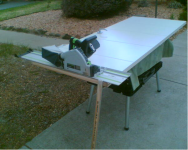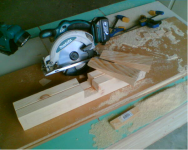juststartingout
Member
- Joined
- Mar 23, 2014
- Messages
- 57
Hi all,
Quick question, I have a solid core door that is currently scraping my wood floor in my home. At first I thought it was due to the wood movement from the floor(it was raining), but it didn't seem to go away a few days after the rain stopped. Then I noticed the hinges had some slop so I drove in some 3" screws to get more threads on the jamb. STILL SAGS and scrapes the floor. It's actually starting to scratch and damage the floor, so I need to trim the door.
My Questions are:
-Can I use the track saw or should I use a planer? I don't currently own a power planer but I do own several hand planes.
-I'm assuming the best way to trim the door is to take a pencil and put it flat on the floor where it's scraping and scribe a line, is that too high?
Thanks,
Oscar
Quick question, I have a solid core door that is currently scraping my wood floor in my home. At first I thought it was due to the wood movement from the floor(it was raining), but it didn't seem to go away a few days after the rain stopped. Then I noticed the hinges had some slop so I drove in some 3" screws to get more threads on the jamb. STILL SAGS and scrapes the floor. It's actually starting to scratch and damage the floor, so I need to trim the door.
My Questions are:
-Can I use the track saw or should I use a planer? I don't currently own a power planer but I do own several hand planes.
-I'm assuming the best way to trim the door is to take a pencil and put it flat on the floor where it's scraping and scribe a line, is that too high?
Thanks,
Oscar




![simple_scribe_scribe[1].JPG](/data/attachments/14/14533-9c6bcb98d80615ff3bdc453f883f733d.jpg?hash=VT5VqaE1Zh)